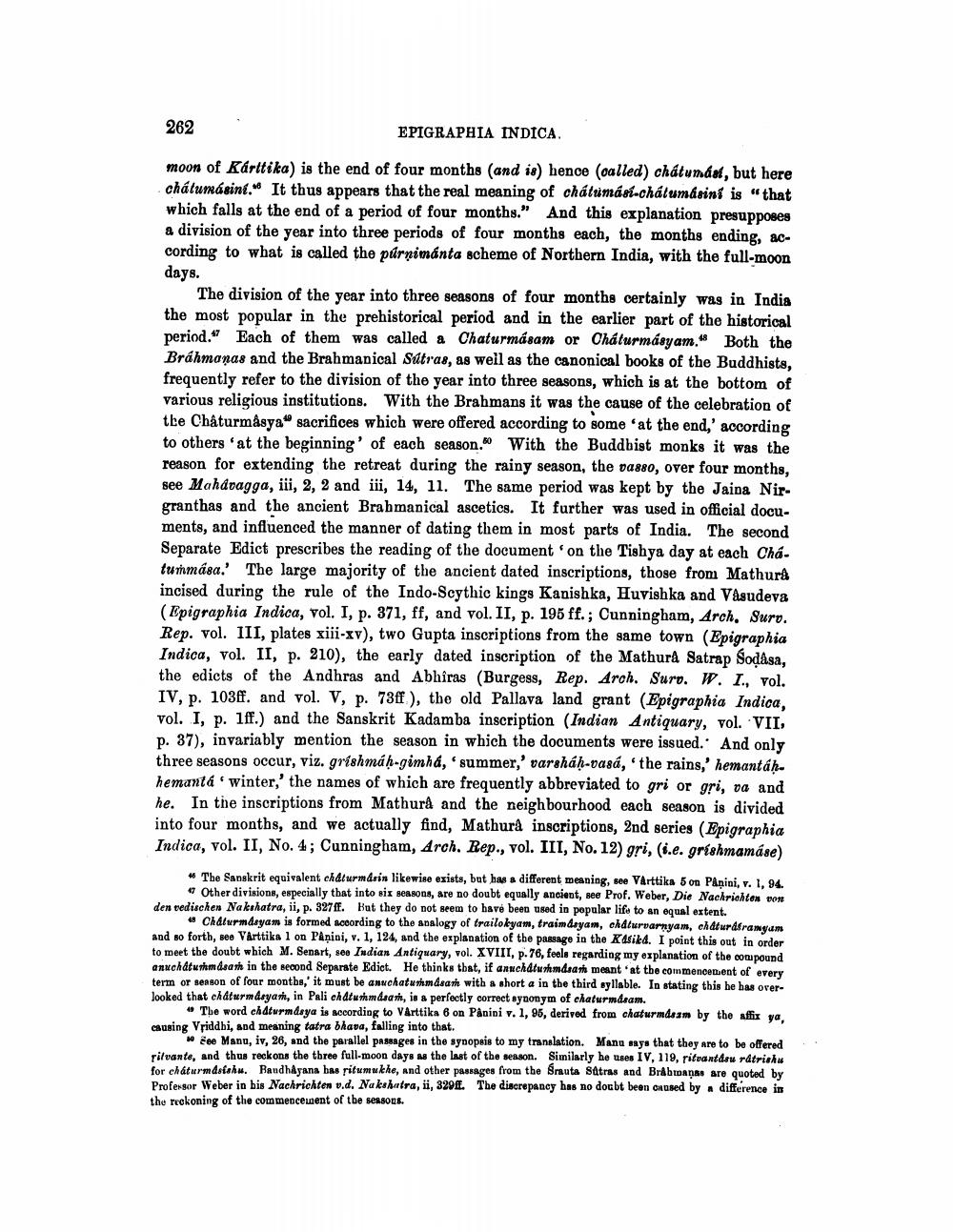________________
262
EPIGRAPHIA INDICA.
moon of Kárttika) is the end of four months (and is) hence (called) chátumás, but here chátumásini." It thus appears that the real meaning of chátumási-chátumásini is that which falls at the end of a period of four months." And this explanation presupposes a division of the year into three periods of four months each, the months ending, according to what is called the purnimánta scheme of Northern India, with the full-moon days.
The division of the year into three seasons of four months certainly was in India the most popular in the prehistorical period and in the earlier part of the historical period." Each of them was called a Chaturmasam or Chaturmásyam. Both the Brahmanas and the Brahmanical sutras, as well as the canonical books of the Buddhists. frequently refer to the division of the year into three seasons, which is at the bottom of various religious institutions. With the Brahmans it was the cause of the celebration of the Châturmasya" sacrifices which were offered according to some at the end,' according to others at the beginning of each season. With the Buddhist monks it was the reason for extending the retreat during the rainy season, the da880, over four months, see Mahdragga, iii, 2, 2 and iii, 14, 11. The same period was kept by the Jaina Nirgranthas and the ancient Brahmanical ascetics. It further was used in official documents, and influenced the manner of dating them in most parts of India. The second Separate Edict prescribes the reading of the document on the Tishya day at each Chátunmása. The large majority of the ancient dated inscriptions, those from Mathura incised during the rule of the Indo-Scythic kings Kanishka, Huvishka and Vasudeva (Epigraphia Indica, vol. I, p. 371, ff, and vol. II, p. 195 ff.; Cunningham, Arch, Surv. Rep. vol. III, plates xiii-xv), two Gupta inscriptions from the same town (Epigraphia Indica, vol. II, p. 210), the early dated inscription of the Mathura Satrap Sodása, the edicts of the Andhras and Abhîras (Burgess, Rep. Arch. Suro. W. I., vol. IV, p. 103ff. and vol. V, p. 73ff), the old Pallava land grant (Epigraphia Indica, vol. I, p. 1ff.) and the Sanskrit Kadamba inscription (Indian Antiquary, vol. VII, p. 37), invariably mention the season in which the documents were issued. And only three seasons occur, viz. grishmáh-gimhd, summer,' varsháh-vasá, 'the rains,' hemantahhemanta winter,' the names of which are frequently abbreviated to gri or gri, va and he. In the inscriptions from Mathura and the neighbourhood each season is divided into four months, and we actually find, Mathura inscriptions, and series (Epigraphia Indica, vol. II, No. 4; Cunningham, Arch. Rep., vol. III, No. 12) gri, (i.e. grishmamáse)
41 The Sanskrit equivalent chaturmdrin likewino exists, but has a different meaning, sve Varttika 5 on Panini, v. 1. 94.
Other divisione, especially that into six sonsons, are no doubt equally ancient, see Prof. Weber, Die Nachrichten von den vedischen Nakshatra, ii, p. 327ff. But they do not seem to have been used in popular life to an equal extent.
Chaturmdayam is formed according to the analogy of trailokyan, traimdeyan, chdturvarnyam, chaturdfrangam and so forth, seo Varttika 1 on Paņini, v. 1, 124, and the explanation of the passage in the Kasikd. I point this out in order to meet the doubt which M. Senart, see Indian Antiquary, vol. XVIII, p. 76, feels regarding my explanation of the compound anucháturhemdean in the second separate Edict. He thinks that, if anschlush mdaas meant at the commencement of every term or season of four months,' it must be anschaturhm daar with a short a in the third syllable. In stating this he has overJooked that cháturm dryan, in Pali chatush mdaan, is a perfectly correct synonym of chaturmdeam.
• The word chdturm daya is according to Varttika 6 on Pånini v. 1, 96, derived from chaturmdsam by the affin ya, causing Vriddhi, and meaning tatra bhava, falling into that.
10 Zee Mana, iv, 26, and the parallel passages in the synopsis to my translation. Mana says that they are to be offered ritvants, and thus reckons the three full-moon days as the last of the season. Similarly he uses IV, 119, ritvartásu rátrishu for chaturmdsísku. Bandhayana bas ritumukhe, and other passages from the Srauta Sutras and Bråbtoaņas are quoted by Professor Weber in bis Nachrichten v.d. Nakshatra, ii, 329. The discrepancy has no doubt been caused by difference in the reckoning of the commencement of the sessous




